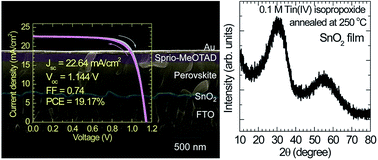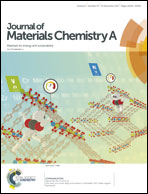Solution-processed SnO2 thin film for a hysteresis-free planar perovskite solar cell with a power conversion efficiency of 19.2%
Abstract
A hysteresis-free and high-efficiency planar perovskite solar cell was developed using a solution-processed SnO2 electron-transporting layer (ETL). Tin(IV) isopropoxide dissolved in isopropanol (IPA) was spin-coated on a fluorine-doped tin oxide (FTO) substrate in a nitrogen atmosphere. The effects of annealing temperature and precursor concentration on the photovoltaic performance were systematically investigated. The annealing temperature was scanned from 100 °C to 500 °C, whereby the 250 °C-annealed SnO2 film demonstrated the best performance along with negligible current–voltage hysteresis. The SnO2 film annealed at 250 °C was X-ray amorphous, while it was observed to be nanocrystallite from SnO2 annealed at 500 °C. The faster stabilization of the photocurrent and lower interfacial capacitance for the 250 °C-annealed SnO2 than for the 500 °C-annealed one were responsible for the markedly reduced hysteresis. The photovoltaic performance and hysteresis were influenced by the precursor concentration, where a concentration of 0.1 M showed hysteresis-free higher performance among the concentrations investigated ranging from 0.05 M to 0.2 M owing to a larger and faster photoluminescence quenching. The planar (HC(NH2)2PbI3)0.875(CsPbBr3)0.125 perovskite that was formed on the 40 nm-thick, 0.1 M-based and 250 °C-annealed SnO2 thin film delivered a power conversion efficiency (PCE) of 19.17% averaged out from the forward scan PCE of 19.40% and the reverse scan PCE of 18.93%.



 Please wait while we load your content...
Please wait while we load your content...